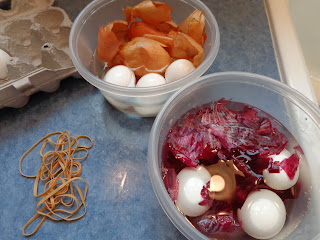My number one son is getting married this summer, and the mother of the bride and I are planning a little shower -- well, not so little! About 90 people are invited!
Of course, I offered months ago to make the invitations. Perhaps if I had known I needed to make 90, I would have given it a second thought, but once committed, I was ready for the challenge.
The bridesmaids wanted to feature all things Spain at the shower, since my future daughter-in-law studied there. This created a design dilemma -- how could I get the theme across in the invitation? I began flipping through "Card Ideas for Paper Crafters" by Papercrafts Magazine (volume one, summer 2011), and found a card template that used scalloped circle die by Spellbinders. It triggered an idea: make the invitations in the shape of a Spanish flamenco dancer's fan.

I found the dies on ebay, and purchased both the Nestabilities Big Scalloped Circle Large, and the Grand Big Scalloped Circles. The second set is designed for the "Grand Calibur" die cutting machine, which I don't have, but I figured one of the smaller dies would work with my little Cuttlebug.
If you're not familiar with Spellbinders dies, this particular style came in a pack of 6 dies of the same design, but each one is a little larger, with the smallest being 4 3/4" in diameter, and the largest being 7 1/2" in diameter. This allows you to cut nesting shapes. It also coordinates with three other die sets, progressively smaller. My hunch was right -- I was able to use the third die, which was 5 3/4" in diameter.
Here's a step-by-step for assembling the cards:
I measured the die and determined that the red cardstock needed to be 6" by 8". (Note to self: don't go looking for red cardstock the week after Valentine's Day -- two craft stores were totally sold out of red!) After cutting the paper to that size, I used my Scor-It tool to crease the cards down the middle. This was an extra step, but it gave me a nice, sharp crease, which made it easier to add the insert.
I printed the party details on regular copy paper using the computer. I trimmed each piece down to the 6" x 8" size, and adhered them to the inside of each card. I did have the test them with the die cut machine first, to be sure I didn't cut off any of the information!
The next step was to die cut the cards. Yes, I did this 90 times!
Notice I made a mark with a Sharpie on the die...this allowed me to line up the fold of the card in the correct spot every time.
With the fold next to my marks, the card is ready to roll through the Cuttlebug. Do you see the piece of tape on the left? It's holding the card so it doesn't shift.
Here we go! I cranked through 90 cards the same way!
Here's the final card, cut exactly to the shape I wanted! After I finished the red cards, I had to do the same with black card stock, patterned paper, and gold sticker paper, making each one a different size. The gold circles later were cut in half with scissors.
Here are stacks of paper, ready to be asssembled.
I put the embellishment papers together assembly-line style...adhering the patterned paper to the black cardstock, and then added the gold half-circle. After that was finished, I added a black or gold eyelet to the embellishment. I used a hole punch and setting tool to affix the eyelets.
Punching the holes...
Adding the eyelet.
Why did I use an eyelet? Well, the last step for the embellishment was adding a tiny tassel. I found these at Home Sew, a notions company located in Bethlehem, Pa. (
http://homesew.com/). I phoned in my order and they arrived just five days later!
So here's the final product! This is as close as I could get to a Spanish fan. Although it did not involve rubber stamping at all, it was a lot of fun the take on the challenge, and I know my future daughter-in-law will be delighted when she sees it.
































